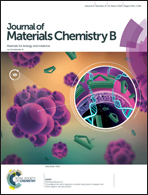Induction of oxidative stress and sensitization of cancer cells to paclitaxel by gold nanoparticles with different charge densities and hydrophobicities†
Abstract
An elevated reactive oxygen species (ROS) level leads to cellular oxidative stress, which has long been associated with diseases, such as cancer. Thus, the understanding and appropriate manipulation of cellular oxidative stress are needed for disease treatment. It has been reported that nanoparticles induce oxidative stress in human cells through different pathways. However, how the physicochemical properties of nanoparticles perturb cellular oxidative stress remains unclear. In this paper, we explored the effects of the positive/negative charge density and hydrophobicity of gold nanoparticles (GNPs) on the induction of oxidative stress and related mechanisms. In multiple human cell lines, we found that only the positive charge density and hydrophobicity of nanoparticles were correlated with the induction of cellular oxidative stress. Hydrophobic nanoparticles generated oxidative stress mainly through NADPH oxidase activation while positively charged nanoparticles generated it through perturbations of the mitochondria and modulation of intracellular Ca2+ concentration. Furthermore, nanoparticle-induced oxidative stress sensitized paclitaxel-induced cancer cell killing by 200%. These findings provided unequivocal structural parameters for the design of future nanomedicine and biocompatible nanocarriers.

- This article is part of the themed collection: International Year of the Periodic Table: Precious metals for cancer treatment


 Please wait while we load your content...
Please wait while we load your content...